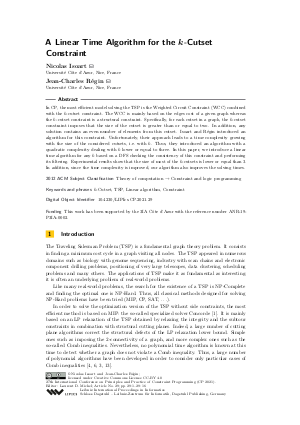A Linear Time Algorithm for the k-Cutset Constraint
Authors Nicolas Isoart, Jean-Charles Régin
-
Part of:
Volume:
27th International Conference on Principles and Practice of Constraint Programming (CP 2021)
Part of: Series: Leibniz International Proceedings in Informatics (LIPIcs)
Part of: Conference: International Conference on Principles and Practice of Constraint Programming (CP) - License:
 Creative Commons Attribution 4.0 International license
Creative Commons Attribution 4.0 International license
- Publication Date: 2021-10-15
File

PDF
LIPIcs.CP.2021.29.pdf
- Filesize: 1.27 MB
- 16 pages
Document Identifiers
Subject Classification
ACM Subject Classification
- Theory of computation → Constraint and logic programming
Keywords
- k-Cutset
- TSP
- Linear algorithm
- Constraint
Metrics
- Access Statistics
-
Total Accesses (updated on a weekly basis)
0PDF Downloads0Metadata Views
Abstract
In CP, the most efficient model solving the TSP is the Weighted Circuit Constraint (WCC) combined with the k-cutset constraint. The WCC is mainly based on the edges cost of a given graph whereas the k-cutset constraint is a structural constraint. Specifically, for each cutset in a graph, the k-cutset constraint imposes that the size of the cutset is greater than or equal to two. In addition, any solution contains an even number of elements from this cutset. Isoart and Régin introduced an algorithm for this constraint. Unfortunately, their approach leads to a time complexity growing with the size of the considered cutsets, i.e. with k. Thus, they introduced an algorithm with a quadratic complexity dealing with k lower or equal to three. In this paper, we introduce a linear time algorithm for any k based on a DFS checking the consistency of this constraint and performing its filtering. Experimental results show that the size of most of the k-cutsets is lower or equal than 3. In addition, since the time complexity is improved, our algorithm also improves the solving times.
Cite As Get BibTex
Nicolas Isoart and Jean-Charles Régin. A Linear Time Algorithm for the k-Cutset Constraint. In 27th International Conference on Principles and Practice of Constraint Programming (CP 2021). Leibniz International Proceedings in Informatics (LIPIcs), Volume 210, pp. 29:1-29:16, Schloss Dagstuhl – Leibniz-Zentrum für Informatik (2021)
https://doi.org/10.4230/LIPIcs.CP.2021.29
BibTex
@InProceedings{isoart_et_al:LIPIcs.CP.2021.29,
author = {Isoart, Nicolas and R\'{e}gin, Jean-Charles},
title = {{A Linear Time Algorithm for the k-Cutset Constraint}},
booktitle = {27th International Conference on Principles and Practice of Constraint Programming (CP 2021)},
pages = {29:1--29:16},
series = {Leibniz International Proceedings in Informatics (LIPIcs)},
ISBN = {978-3-95977-211-2},
ISSN = {1868-8969},
year = {2021},
volume = {210},
editor = {Michel, Laurent D.},
publisher = {Schloss Dagstuhl -- Leibniz-Zentrum f{\"u}r Informatik},
address = {Dagstuhl, Germany},
URL = {https://drops.dagstuhl.de/entities/document/10.4230/LIPIcs.CP.2021.29},
URN = {urn:nbn:de:0030-drops-153200},
doi = {10.4230/LIPIcs.CP.2021.29},
annote = {Keywords: k-Cutset, TSP, Linear algorithm, Constraint}
}
Author Details
Funding
This work has been supported by the 3IA Côte d’Azur with the reference number ANR-19-P3IA-0002.
References
-
David L Applegate, Robert E Bixby, Vasek Chvatal, and William J Cook. The traveling salesman problem: a computational study. Princeton university press, 2006.

- Pascal Benchimol, Willem-Jan Van Hoeve, Jean-Charles Régin, Louis-Martin Rousseau, and Michel Rueher. Improved filtering for weighted circuit constraints. Constraints, 17(3):205-233, 2012. URL: https://hal.archives-ouvertes.fr/hal-01344070.
- Václav Chvátal. Edmonds polytopes and weakly hamiltonian graphs. Math. Program., 5(1):29-40, 1973. URL: https://doi.org/10.1007/BF01580109.
- Jack Edmonds. Paths, Trees, and Flowers. Canadian Journal of Mathematics, 17:449–467, 1965. URL: https://doi.org/10.4153/CJM-1965-045-4.
-
Jean-Guillaume Fages, Xavier Lorca, and Louis-Martin Rousseau. The salesman and the tree: the importance of search in CP. Constraints, 21(2):145-162, 2016.

- Martin Grötschel and Manfred Padberg. On the symmetric travelling salesman problem i: Inequalities. Mathematical Programming, 16:265-280, December 1979. URL: https://doi.org/10.1007/BF01582116.
-
Robert Haralick and Gordon Elliott. Increasing Tree Search Efficiency for Constraint Satisfaction Problems. Artificial Intelligence, 14:263-313, January 1979.

-
Michael Held and Richard M. Karp. The traveling-salesman problem and minimum spanning trees. Operations Research, 18(6):1138-1162, 1970.

-
Michael Held and Richard M. Karp. The traveling-salesman problem and minimum spanning trees: Part ii. Mathematical Programming, 1(1):6-25, 1971.

-
Nicolas Isoart and Jean-Charles Régin. Integration of structural constraints into tsp models. In Thomas Schiex and Simon de Givry, editors, Principles and Practice of Constraint Programming, pages 284-299, Cham, 2019. Springer International Publishing.

-
Nicolas Isoart and Jean-Charles Régin. Adaptive CP-Based Lagrangian Relaxation for TSP Solving. In Emmanuel Hebrard and Nysret Musliu, editors, Integration of Constraint Programming, Artificial Intelligence, and Operations Research, pages 300-316, Cham, 2020. Springer International Publishing.

-
Christophe Lecoutre, Lakhdar Saïs, Sébastien Tabary, and Vincent Vidal. Reasoning from last conflict(s) in constraint programming. Artificial Intelligence, 173(18):1592-1614, 2009.

-
Adam N. Letchford and Andrea Lodi. Polynomial-Time Separation of Simple Comb Inequalities. In William J. Cook and Andreas S. Schulz, editors, Integer Programming and Combinatorial Optimization, pages 93-108, Berlin, Heidelberg, 2002. Springer Berlin Heidelberg.

-
Gerhard Reinelt. TSPLIB - A Traveling Salesman Problem Library. ORSA Journal on Computing, 3(4):376-384, 1991.

-
Meinolf Sellmann. Theoretical Foundations of CP-Based Lagrangian Relaxation. In Principles and Practice of Constraint Programming - CP 2004, 10th International Conference, CP 2004, Toronto, Canada, September 27 - October 1, 2004, Proceedings, pages 634-647, 2004.

-
Robert E. Tarjan. A note on finding the bridges of a graph. Inf. Process. Lett., 2:160-161, 1974.

-
Robert E. Tarjan. Data Structures and Network Algorithms. CBMS-NSF Regional Conference Series in Applied Mathematics, 1983.

-
Yung H. Tsin. Yet another optimal algorithm for 3-edge-connectivity. Journal of Discrete Algorithms, 7(1):130-146, 2009. Selected papers from the 1st International Workshop on Similarity Search and Applications (SISAP).

